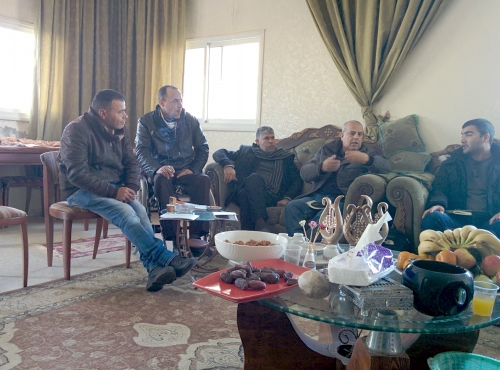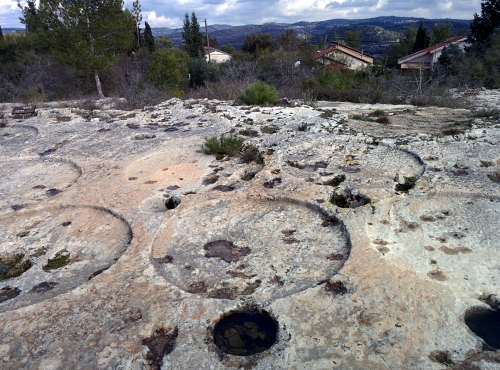Haris, Nabi Salah
Today’s shift was devoted to a meeting in Nabi Salah between Palestinians from Nabi Salah and Haris, a representative of “Rozana,” from Bir Zeit,who is engaged in preserving Palestinian heritage sites and organizing tours to visit them, three archaeologists from “Emeq Shaveh” (Yoni, Gideon, and Salah from Bethlehem), and us from MachsomWatch, including Tzvia who also represented Yesh Din. Fifteen people met in N.’s home. The overwhelming majority was Palestinian, and the dominant language was Arabic. The four of us got a minimal translation. But, by concentrating very hard, and with a great deal of prior preparation, I don’t think we missed any of the discussion’s main points.
The purpose of the meeting was to discuss practical steps to gain access for Palestinians to the Huvlata antiquities site in Halamish and the thirty dunums of antiquities in Barkan, near Haris. N. and A. knew both sites as children and they miss them greatly.
N., from Nabi Salah, and A., from Hars, know the owners of the land of these two sites. The archaeologist say that will be helpful when we demand access. N., a veteran of many demonstrations, was very much in favor of the attempt. Experienced in how the occupation forces retaliate, he doesn’t fear them. He’s determined to try any form of non-violent protest. He described something outrageous: when the demonstrations in Nabi Salah began in 2010, the army linked the demonstrations to the intensive social, cultural, and educational activities carried out in the village’s maqam that had been restored in 2004 - and sabotaged it. Culture threatens!
We also hope to make the same link as the army had done between culture and protest, but in reverse.
All along the road to Huvlata (Halamish) and Al Burkh (Barkan) the village children can be taught wonderful lessons about different types of wine presses during the Roman and Byzantine periods, the transition from cultivating grapes to growing olives, and participating in tours that begin at Maqam Nabi Salah, with its three levels and wonderful vista, which is interrupted by the new town of Rawabi. The restored maqam cries out to begin hosting activities again.
The antiquities sites are so close to the villages geographically, but so far away from them because of the occupation’s restrictions. N. is very willing to cooperate. During the two months since we first met he has constantly helped by providing information, touring with us, giving us telephone numbers of possible partners. A true leader, courageous, stubborn, encouraging, and precise. More than once, and also yesterday, I’ve felt he’s been preparing the ground to make it possible for things to happen. As a leader, he’s well aware, on the one hand, of the danger he’s exposing himself to, but, on the other, he hesitates to be overly enthusiastic in order not to arouse false hopes among the villagers.
A., from Hars, has begun interviewing on video Palestinians who work in Barkan regarding the condition of the Al Burkh site. A. has been blacklisted because his back was injured by an army bullet during a night raid on his village fifteen years ago, when his oldest son was two months old. Since then he’s been paralyzed from the waist down. That didn’t dissuade him from his support of non-violent resistance to the occupation. A. is one of the founders and activists of the I.S.M. He intends to organize people to clean the site when the rainy season ends. We’ll participate.
Rif’at Jamil, from Bir Zeit, a member of Rozana, recounted a long story (in Arabic, of course), sounding like a storyteller, a tale containing the essence of Rozana’s activities related to the Israel/Palestine conflict.
The story is of a German father who has warned his son travelling to Israel not to have any contact with the dangerous Palestinians. The son didn’t obey and discovered that the Palestinians were actually quite nice. He told his father, who became a friend of the Arabs.
The story also addresses the widespread slandering of the victims and indicates what one can do in one's own environment: show the positive side of Palestinian society and culture.
I asked him to suggest for us a tour among Palestinian heritage sites, about five hours long, and he was very happy to do so (the tour will be in English).
To turn this idea into an actual activity will requires much more work and patience. But I’m encouraged by the thought that this applies to all the villages in Area C, and if we’re successful in one place perhaps the idea will spread.
To conclude: After the meeting in Nabi Salah, I met with Kobi, one of the Israeli demonstrators, who have been participating since the demonstrations began in the area: in Budrus, Bil’in, Nabi Salah and lastly in Ni’ilin, which is still not as well-organized – to ask the question I haven’t yet dared ask the Palestinians: does the fact that the demonstrations take place in olive groves, whose land and trees are damaged by the protests, lead to conflict between the demonstrators and their leaders and the owners of the groves and land that is being damaged?
Yes! he replied. That does lead to conflict, which reduces the motivation to demonstrate. The result is an absurd situation in which the demonstrations are important symbolically but the harm to the landowners is real. That’s unfortunate, and is a reason to seek other forms of protest that don’t create internal conflicts in a society already under attack.

Naji Tamimi at the meeting in Nabi Salah. On the floor is a copy of “Landowner’s Rights” that the archaeologists brought.

The ancient wine presses in Huvlata.
